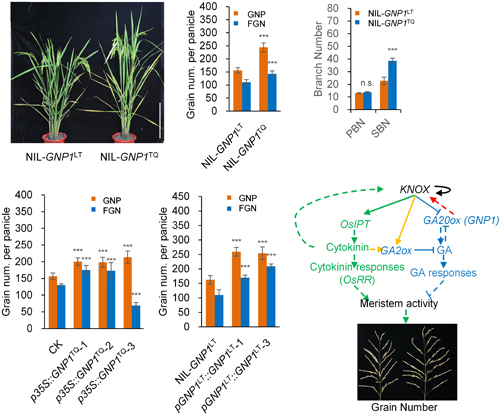A QTL GNP1 Increases Grain Number and Yield by Increasing Cytokinin Activity in Rice
Rice panicle architecture, a valuable composite agronomic trait that includes grain number per panicle (GNP), panicle length and so on, is strongly associated with rice grain yield. Grain number is profoundly affected by reproductive meristem activity. This activity, in turn, is controlled by transcriptional and plant hormone regulators, especially KNOX proteins and cytokinins. To improve rice grain yields for the needs of the rapidly growing population, numerous studies have focused on identifying and cloning genes/QTLs contributing to rice grain number. However, little is known about the roles of gibberellins (GAs) in these processes and how the regulatory network functions due to the complexity of crosstalk between plant hormone regulators.
At October 20, 2016, a work entitled “The QTL
GNP1 Encodes GA20ox1, Which Increases Grain Number and Yield by Increasing Cytokinin Activity in Rice Panicle Meristems” was published in
PLOS Genetics (
http://dx.doi.org/10.1371/journal.pgen.1006386). This work was co-contributed by Dr. Yuan Wu in a group led by Professor Hong-Xuan Lin (Shanghai Institute of Plant Physiology and Ecology, CAS) and Dr. Yun Wang in professor Jian-Long Xu’s group (Institute of Crop Sciences/National Key Facility for Crop Gene Resources and Genetic Improvement, Beijing). In this study, with the help of map-based cloning, they report the identification and characterization of a QTL,
Grain Number per Panicle1 (GNP1), which encodes rice GA biosynthetic protein OsGA20ox1. They propose that the upregulation of
GNP1 in the inflorescence meristems may increase cytokinin activity via a KNOX-mediated feedback regulation loop and increase GA catabolism activity through inducing the expression of
GA2oxs. This process would result in increased cytokinin activity, rebalancing cytokinin and GA activity and increasing grain number and grain yield. These results provide insights into the mechanism underlying KNOX-mediated cytokinin and GA crosstalk during rice inflorescence meristem development, and they suggest that
GNP1 is a valuable target gene for high yield rice breeding (with a 5.7~9.6% increase in grain yield).
This work was funded by the National Natural Science Foundation of China, the Ministry of Science and Technology of China, Chinese Academy of Sciences and the Shenzhen Peacock Plan and the Shenzhen Technology Research & Development.
Figure 1. The QTL GNP1 shows positive effects on rice development, primarily on inflorescence development, especially secondary branch number and grain number, leading to a significant increase in grain yield (5.7~9.6%). These findings provide new insights into the mechanism underlying KNOX-mediated cytokinin and GA crosstalk during rice inflorescence meristem development.
CONTACT:
Dr. Hongxuan Lin, PhD, Professor
Institute of Plant Physiology & Ecology (SIPPE)
Chinese Academy of Sciences
300 Fenglin Road
Shanghai 200032, China
Email:
hxlin@sibs.ac.cn
